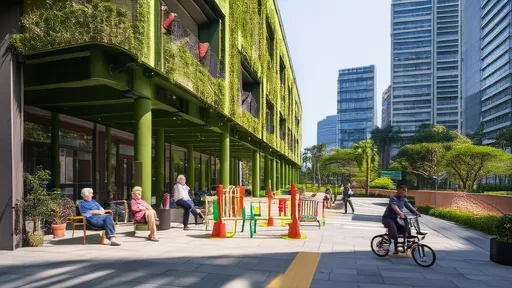In an era where urban dwellers increasingly retreat behind screens, Singapore stands out as a living laboratory for combating social isolation through intentional city planning. The island nation's approach transcends mere infrastructure—it weaves human connection into the very fabric of neighborhoods. From hawker centers that double as communal living rooms to "kampung spirit"-inspired housing policies, Singapore demonstrates how physical environments can nurture psychological belonging.
The Hawker Center Phenomenon
No discussion of Singapore's social architecture is complete without its legendary hawker centers. These UNESCO-recognized food paradises serve as the city's beating heart, where bankers share tables with construction workers over $3 chicken rice. The government deliberately designs these spaces with shared benches and centralized seating to force organic interactions. "You can't eat alone here without someone asking to join your table," observes urban sociologist Dr. Lim Wei Chen. "The lack of personal space becomes a feature, not a bug."
What began as pragmatic urban hygiene solutions in the 1970s evolved into social equalizers. By locating hawker centers within walking distance of all HDB flats and pricing meals affordably, Singapore created a rare space where social strata dissolve. Recent redesigns incorporate community kitchens where retirees teach youth traditional recipes—a culinary exchange that bridges generations.
Housing as Social Glue
Singapore's public housing policy represents perhaps the world's most ambitious social engineering project. With over 80% of residents living in HDB flats, the government uses apartment allocation to prevent ethnic enclaves and foster diversity. Each block intentionally mixes Chinese, Malay, and Indian families through ethnic integration quotas established after racial riots in the 1960s.
The urban planning goes deeper than demographics. Void decks—those open-air ground floors beneath apartment blocks—function as impromptu community centers. From Malay wedding receptions to Chinese funeral wakes, these intentionally empty spaces fill with life's milestones. "We designed them as blank canvases for spontaneous gatherings," reveals former HDB architect Tan Peng Hing. "The absence of predetermined function creates possibility."
Green Spaces That Connect
Singapore's "City in a Garden" ambition manifests in over 300km of park connectors—linear greenways linking neighborhoods like botanical arteries. Unlike isolated parks, these continuous ribbons of nature encourage chance encounters. The Southern Ridges trail, for instance, transforms commutes into social experiences with its undulating Henderson Waves bridge, where strangers pause together to admire sunset views.
Community gardens take this further by making residents co-creators of their environment. Over 1,500 such plots dot the city, tended by multiethnic groups who exchange gardening tips and cultural traditions. "We didn't just want pretty plants," explains National Parks CEO Kenneth Er. "The dirt under fingernails is where real connections grow."
Playful Urban Interventions
Singapore's urban designers employ subtle "nudge architecture" to spark interaction. Bus stops feature bench designs that angle strangers toward conversation. Public pianos appear in housing estates with "Play Me" signs. Even trash bins get placed in pairs to encourage people to approach together.
The recently revamped Bishan-Ang Mo Kio Park exemplifies this philosophy. Its redesigned riverbank eliminates railings, creating natural gathering spots where parents watch children splash in shallow waters. "Risk-taking in design leads to social bonding," notes landscape architect Adib Jalal. "When people share a slight sense of danger—even just wet feet—they start talking."
The Digital Counterbalance
Paradoxically, Singapore leverages technology to combat tech-induced isolation. The Smart Nation initiative includes apps like "kampungVR" that use augmented reality to overlay historical stories onto physical neighborhoods, prompting residents to explore together. Community centers offer coding classes where seniors learn from teenagers—inverting traditional mentorship models.
This digital-physical hybrid approach appears in housing too. New HDB blocks feature "smart corridors" with motion-activated screens showing neighbors' hobby groups. It's a high-tech twist on the traditional kampung practice of leaving doors open. As sociologist Priya Nair observes: "The goal isn't to reject modernity, but to hack it for human connection."
Singapore's urban experiment proves that against global trends of social fragmentation, cities can architect belonging. By treating every bench, walkway, and void deck as social infrastructure, this island nation writes a playbook for connection in the age of isolation—one hawker meal and chance encounter at a time.

By /Jul 28, 2025

By /Jul 28, 2025

By /Jul 28, 2025

By /Jul 28, 2025

By /Jul 28, 2025

By /Jul 28, 2025

By /Jul 28, 2025

By /Jul 28, 2025

By /Jul 28, 2025

By /Jul 28, 2025

By /Jul 28, 2025

By /Jul 28, 2025

By /Jul 28, 2025

By /Jul 28, 2025

By /Jul 28, 2025

By /Jul 28, 2025

By /Jul 28, 2025

By /Jul 28, 2025

By /Jul 28, 2025

By /Jul 28, 2025